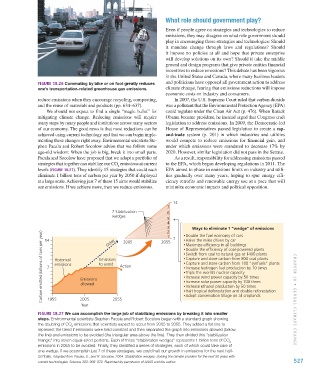Page 528 - Environment: The Science Behind the Stories
P. 528
What role should government play?
Even if people agree on strategies and technologies to reduce
emissions, they may disagree on what role government should
play in encouraging those strategies and technologies: Should
it mandate change through laws and regulations? Should
it impose no policies at all and hope that private enterprise
will develop solutions on its own? Should it take the middle
ground and design programs that give private entities financial
incentives to reduce emissions? This debate has been vigorous
in the United States and Canada, where many business leaders
Figure 18.26 Commuting by bike or on foot greatly reduces and politicians have opposed all government action to address
one’s transportation-related greenhouse gas emissions. climate change, fearing that emissions reductions will impose
economic costs on industry and consumers.
reduce emissions when they encourage recycling, composting, In 2007, the U.S. Supreme Court ruled that carbon dioxide
and the reuse of materials and products (pp. 634–637). was a pollutant that the Environmental Protection Agency (EPA)
We should not expect to find a single “magic bullet” for could regulate under the Clean Air Act (p. 476). When Barack
mitigating climate change. Reducing emissions will require Obama became president, he instead urged that Congress craft
many steps by many people and institutions across many sectors legislation to address emissions. In 2009, the Democratic-led
of our economy. The good news is that most reductions can be House of Representatives passed legislation to create a cap-
achieved using current technology and that we can begin imple- and-trade system (p. 201) in which industries and utilities
menting these changes right away. Environmental scientists Ste- would compete to reduce emissions for financial gain, and
phen Pacala and Robert Socolow advise that we follow some under which emissions were mandated to decrease 17% by
age-old wisdom: When the job is big, break it into small parts. 2020. However, similar legislation did not pass in the Senate.
Pacala and Socolow have proposed that we adopt a portfolio of As a result, responsibility for addressing emissions passed
strategies that together can stabilize our CO emissions at current to the EPA, which began developing regulations in 2011. The
2
levels (Figure 18.27). They identify 15 strategies that could each EPA aimed to phase in emissions limits on industry and utili-
eliminate 1 billion tons of carbon per year by 2050 if deployed ties gradually over many years, hoping to spur energy effi-
at a large scale. Achieving just 7 of these 15 aims would stabilize ciency retrofits and renewable energy use at a pace that will
our emissions. If we achieve more, then we reduce emissions. minimize economic impacts and political opposition.
14
7
7 Stabilization 6
wedges
5
4
3 7 Double the fuel economy of cars
Ways to eliminate 1 “wedge” of emissions
2
Carbon emitted (billions of tons per year) 7 Historical Emissions Emissions Action Double the efficiency of coal-powered plants
1
Delay
Halve the miles driven by car
14
2005
2055
Maximize efficiency in all buildings
Switch from coal to natural gas at 1400 plants
Capture and store carbon from 800 coal plants
Capture and store carbon from 180 “synfuels” plants
to avoid
emissions
Increase hydrogen fuel production by 10 times
Triple the world’s nuclear capacity
Increase wind power capacity by 50 times
Increase solar power capacity by 700 times
allowed
Halt tropical deforestation and double reforestation
Adopt conservation tillage on all croplands
2005
1955
Year 2055 Increase ethanol production by 50 times CHAPTER 18 • Glob al Cli M aT e Chan G e
Figure 18.27 We can accomplish the large job of stabilizing emissions by breaking it into smaller
steps. Environmental scientists Stephen Pacala and Robert Socolow began with a standard graph showing
the doubling of CO emissions that scientists expect to occur from 2005 to 2055. They added a flat line to
2
represent the trend if emissions were held constant and then separated the graph into emissions allowed (below
the line) and emissions to be avoided (the triangular area above the line). They then divided this “stabilization
triangle” into seven equal-sized portions. Each of these “stabilization wedges” represents 1 billion tons of CO
2
emissions in 2055 to be avoided. Finally, they identified a series of strategies, each of which could take care of
one wedge. If we accomplish just 7 of these strategies, we could halt our growth in emissions for the next half-
century. Adapted from Pacala, S., and R. Socolow, 2004. Stabilization wedges: Solving the climate problem for the next 50 years with
current technologies. Science 305: 968–972. Reprinted by permission of AAAS and the author. 527
M18_WITH7428_05_SE_C18.indd 527 12/12/14 4:05 PM

